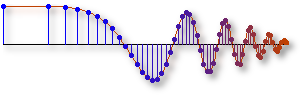8. Discrete Fourier Transform Labs - MATLAB 2
The objective of this lab is to introduce more complicated signals that are related to the basic sinusoid.
These signals which implement frequency modulation (FM) and amplitude modulation (AM) are widely used in
communication systems such as radio and television. In addition, they can be used to create interesting
sounds that mimic musical instruments. The resulting signal
can be analyzed to show its time-frequency behavior by using the spectrogram.
This lab studies signal synthesis for AM and FM signals, and their time-frequency content as shown in
a spectrogram. An underlying objective of the lab is to learn more about the spectrogram.
The objective of this lab is to study further the spectral content of signals analyzed via the spectrogram.
There are several specific steps that will be considered in this lab:
- Synthesize a linear-FM chirp with a MATLAB M-file, and display its spectrogram. Choose the chrip parameters so that aliasing will happen.
- Synthesize a periodic triangle wave with a MATLAB M-file, and display its spectrogram. Relate the harmonic line spectrum to the fundamental period of the triangle wave.
- Compare spectrograms using different scales for amplitude: decibels (dB) for amplitude versus linear amplitude.
- Examine details of the harmonic lines in the dB spectrogram of the triangle wave.
- Spectrogram: make a spectrogram of your voice signal, and relate the harmonic line spectrum to your previous measurement of pitch period.
